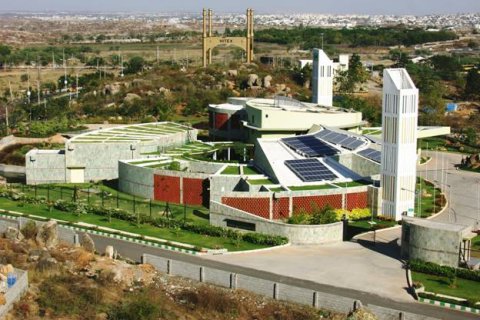BUILDING A GREEN TOMORROW

The CII-GBC at the Ranga Reddy district in Andhra Pradesh uses
30 per cent less energy compared to a normal building because of its ‘green’ structure.
BY GAYATRI PARAMESWARAN
An organization in one of India's
largest states is charting out the future of India's Green Building
Movement, a project it has been pioneering for nearly a decade
With the mercury rising over 40 degrees Celsius, it has been a long, sweltering summer of 2009 in many parts of India.
The prolonged summer – gradually
becoming a regular phenomenon – is something experts believe to be an
outcome of global warming.
Changes already evident
The effects of this feature are
already evident in many walks of human life – shortage of food grains,
scarcity of water, paucity of power etc – apart from its impacts on the
environment.
In a situation as grim as this, it won't take an expert to predict that a brighter future lies in combating climate change.
The Confederation of Indian
Industry-Green Building Centre (CII-GBC) located in Ranga Reddy
district of the southern Indian state of Andhra Pradesh is one business
organization that seems to have taken the cue.
Green Building Movement
With a structure that is an
architectural marvel, its complex sprawls over 20,000 sq ft and is
India's first Leadership in Energy and Environmental design (LEED)
platinum rated building.
The CII-GBC has much more to be
proud of beyond its swanky exterior – it has been the country's pioneer
in the Green Building Movement.
The journey can be traced back to
March 2000, when then US President Bill Clinton, on his official visit,
initiated an idea to design and build an environment friendly business
centre in the state. It wasn't too long before it became reality.
“The centre was proposed to be
owned and managed by CII, the land to be provided by the state.
Jamshedji Godrej group of industries paid the building cost and US
Agency for International Development (USAID) offered technical
assistance,” S Raghupathy, senior director of the CII-GBC, told this
reporter
In March 2004, after three years of
sweat and blood the CII-GBC was finally open for people to touch and
feel the magnificence of a green building.
Great potential
It didn't take too long for the
higher management of the centre to realize the potential they held to
begin a movement in India.
“By 2003, I was part of the World
Green Business Council. While I was in Austin attending a conference, I
was convinced that green business is the future and if India was to be
on the map, we'd better get started,” Raghupathy explained.
Soon the CII-GBC expanded its aims
of combating climate change, infusing energy efficiency, spreading
awareness et al to macro level. Its objectives were now to make India a
leader in the Green Building Movement and further reduce costs involved
in the process of constructing green buildings.
“In a country like India, it might
become difficult to make people understand the ill effects of climate
change. The level of literacy and awareness isn't that high. It
therefore became important to weigh benefits of a green building in
terms of money.”
“With the response we received, we
realised that businesses were more interested in cutting costs than
anything else and green buildings do exactly that,” Raghupathy said
while talking about providing green solutions to businesses.
Innovative awareness campaign
The CII-GBC didn't restrict
itself to business while giving out the green word; they spread their
wings further and reached the education sector. Architecture colleges
in Andhra Pradesh began having sessions in green buildings and even
inculcated it as a part of their curriculum.
The next challenge for CII-GBC was to widen its spectrum for creating awareness beyond just the major cities.
“India has more than 100 small
cities. We soon realized that the movement was restricted to a few
metropolises. We began adding local chapters to the national movement.
Today we are functioning in 12 cities apart from nine local chapters,”
Raghupathy added.
In the future…
So what's the future of this
project? “When the Indian Green Business Council was first formed,
India was nowhere on the Green Building Footprint table. Today we are
second, leaving developed countries like Australia and Canada trailing
behind.
At present we have 400 green
buildings. By 2012 we aim to have 1bn sq ft of green constructions.
It's not easy because the concept is fairly new to India, the level of
awareness isn't high, green materials aren't easily available et al,”
Raghupathy concluded.
While the path for the CII-GBC has been long, arduous and winding, they sure hope to find greener pastures ahead.
Gayatri
Parameswaran, currently an Erasmus Mundus student, graduated as a
Bachelor of Mass Media in Journalism from University of Mumbai. Her
involvement in nature and climate change issues took root at the
University, where she was an active part of the nature club. Being a
journalist for a year after completing her bachelor's degree helped
probe this avenue further.